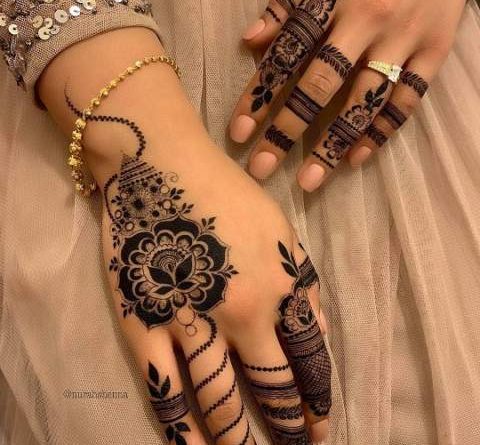New Mehndi Designs
Are you a fan of intricate artistry and cultural traditions and new mehndi designs? If so, you’re likely no stranger to the mesmerizing allure of mehndi designs. These intricate patterns, crafted with henna paste, have adorned the hands and feet of individuals across various cultures for centuries. In this blog post, we’re diving deep into the magic of new mehndi designs, exploring their history, significance, and the creative explosion of contemporary styles.
Mehndi, also known as henna art, is a form of natural body adornment that has been cherished for centuries. With origins in South Asia, North Africa, and the Middle East, mehndi has taken on various forms and meanings across cultures. In recent years, a fascinating blend of tradition and contemporary creativity has given rise to new mehndi designs that captivate both the young and old.
From its humble beginnings as a symbol of joy and auspiciousness, mehndi has evolved into an intricate art form. Its historical significance is deeply rooted in weddings, festivals, and celebratory occasions. While its traditional application remains prevalent, modern mehndi designs incorporate innovative patterns and concepts that reflect the dynamism of the present era.
The dichotomy between traditional and contemporary mehndi designs showcases the adaptability of this ancient art. Traditional designs often feature elaborate motifs inspired by nature, culture, and spirituality. In contrast, contemporary designs embrace minimalism, geometric patterns, and fusion with other art forms, reflecting the changing preferences of the modern generation.
Modern mehndi designs incorporate elements like minimalistic florals, abstract geometrics, and negative space utilization. These elements add a touch of uniqueness and freshness to the designs while maintaining the essence of tradition.
Celebrities have played a pivotal role in popularizing new mehndi designs. Their appearances at events adorned with innovative henna patterns have influenced trends and encouraged enthusiasts to experiment with their own styles.
Creating mehndi designs has become more accessible through DIY tutorials and easy-to-use cones. Tips and techniques for beginners help them achieve stunning designs without the need for professional artists.
Mehndi holds special significance in weddings, festivals, and religious ceremonies. It symbolizes blessings, love, and joy, and its diverse designs cater to various occasions.
Different regions have their own mehndi styles influenced by culture, history, and local artistry. Exploring these variations provides a deeper understanding of the art’s global impact.
Mehndi is not just about intricate designs; it’s about celebrating the body. It promotes body positivity and self-expression, encouraging people to embrace their unique beauty.
Brides adorn their hands and feet with intricate mehndi designs, often incorporating hidden initials or messages from their partners. This tradition adds a personal touch to the art.
Mehndi embodies celebration and marks important life milestones. Whether it’s a wedding, pregnancy, or other significant event, mehndi captures the joy of the moment.
The allure of mehndi has transcended cultural boundaries, influencing global fashion trends. Designers incorporate mehndi-inspired elements into clothing, accessories, and even runway shows.
Advancements in application methods, like white henna and metallic mehndi, have introduced a new dimension to the art. These innovations offer versatility and creative possibilities.
While embracing modernity, it’s essential to preserve the cultural significance of mehndi. This involves passing down traditional designs, techniques, and stories to future generations.
Table of Contents
- Introduction about New Mehndi Designs
- The Rich History of new Mehndi designs
- The Significance of new Mehndi Designs
- Evolution of Mehndi: From Tradition to Trend
- The Art of Applying Mehndi: Techniques and Tools
- Exploring New Mehndi Design Trends
- 6.1 Fusion of Traditional and Modern Elements
- 6.2 Minimalistic Marvels: Less is More
- 6.3 Storytelling through Patterns: Narrative Mehndi
- Mehndi for Different Occasions
- 7.1 Bridal Mehndi: A Journey of Love and Togetherness
- 7.2 Festival Frenzy: Mehndi for Celebrations
- 7.3 Casual Chic: Everyday Mehndi Delights
- Tips for Maintaining and Enhancing Your Mehndi
- The Global Phenomenon: Mehndi’s Universal Appeal
- Mehndi as a Form of Self-Expression
- Embracing Diversity: Cultural Exchange through Mehndi
- The Psychology Behind Mehndi Admiration
- Unveiling the Magic: How Mehndi Boosts Confidence
- Join the Mehndi Movement: Trying It Yourself
- Conclusion
Introduction about new Mehndi designs
The captivating allure of mehndi designs has a universal charm that transcends borders and cultures. From its historical roots to its contemporary adaptations, mehndi is more than just body art—it’s a canvas of self-expression and cultural identity.
The Rich History of new Mehndi designs
Mehndi, also known as henna, has an ancient history steeped in traditions across Asia, the Middle East, and North Africa. Its origins can be traced back over 5,000 years to ancient Egypt and India. The intricate designs were initially used to adorn the hands and feet of brides, symbolizing love, joy, and new beginnings.
The Significance of new Mehndi Designs
Mehndi is more than a mere ornament; it holds deep cultural and spiritual significance. The natural dye of henna is believed to bring good luck, ward off evil, and bless the wearer with prosperity. Its reddish-brown stain represents the intensity of love in a marriage, making bridal mehndi an integral part of wedding rituals.
Evolution of Mehndi: From Tradition to Trend
While steeped in tradition, mehndi designs have evolved over time, reflecting changing aesthetics and preferences. What was once reserved for weddings and religious festivals has transformed into a mainstream trend, embraced by people of various backgrounds for its intricate beauty.
The Art of Applying Mehndi: Techniques and Tools
The process of applying mehndi involves intricate techniques and specialized tools. The henna paste is carefully applied to the skin using cones or brushes, and the design is left to dry for several hours. Once the paste is scraped off, a rich stain develops, resulting in the intricate patterns that mehndi is known for.
Exploring New Mehndi Design Trends
6.1 Fusion of Traditional and Modern Elements
Contemporary mehndi artists often blend traditional patterns with modern elements, creating a harmonious fusion of old and new. This approach results in designs that pay homage to tradition while appealing to modern sensibilities.
6.2 Minimalistic Marvels: Less is More
In a world of complexity, minimalistic mehndi designs have emerged as a breath of fresh air. These designs focus on simplicity and negative space, showcasing that sometimes, less truly is more.
6.3 Storytelling through Patterns: Narrative Mehndi
Narrative mehndi designs tell intricate stories through their patterns. From love stories to epic tales, these designs transform hands and feet into pages of a visual storybook.
Mehndi for Different Occasions
7.1 Bridal Mehndi: A Journey of Love and Togetherness
Bridal mehndi remains a cherished tradition, symbolizing the bride’s transformation and the couple’s journey into marital bliss. Elaborate and intricate, bridal mehndi often incorporates personalized elements that hold special meaning.
7.2 Festival Frenzy: Mehndi for Celebrations
Mehndi is an integral part of festive celebrations like Eid and Diwali. The vibrant designs mirror the joyous spirit of these occasions, adding an extra layer of exuberance to the festivities.
7.3 Casual Chic: Everyday Mehndi Delights
Mehndi needn’t be reserved for grand events alone. Casual mehndi designs offer a touch of elegance for everyday life, allowing individuals to embrace this art form in their day-to-day routines.
Tips for Maintaining and Enhancing Your Mehndi designs
The Global Phenomenon: Mehndi’s Universal Appeal
Mehndi as a Form of Self-Expression
Embracing Diversity: Cultural Exchange through Mehndi designs
The Psychology Behind Mehndi Admiration
Unveiling the Magic: How Mehndi Boosts Confidence
Join the Mehndi Movement: Trying It Yourself
Conclusion
Mehndi designs are more than just temporary body art; they represent a cultural bridge that connects the past and present, tradition and modernity. Their intricate beauty and universal appeal continue to captivate hearts and hands across the globe. So why wait? Embrace the magic of mehndi and let your skin tell stories of love, celebration, and self-expression.
FAQs
- Q: How long do mehndi designs typically last? A: Mehndi designs usually last around 1 to 3 weeks, depending on factors like skin type and aftercare.
- Q: Can I create my own mehndi designs at home? A: Absolutely! There are numerous DIY mehndi kits and tutorials available that can help you get started.
- Q: Are there any cultural taboos associated with mehndi? A: While mehndi is generally embraced across cultures, it’s essential to be mindful of its significance and avoid appropriating its cultural context.
- Q: Can men also wear mehndi designs? A: Yes, men can also adorn mehndi designs. In some cultures, mehndi is worn during special occasions and celebrations.
- Q: How does mehndi relate to self-confidence? A: Mehndi’s transformative nature often boosts confidence, as the intricate designs can make individuals feel empowered and enhance their self-image.



